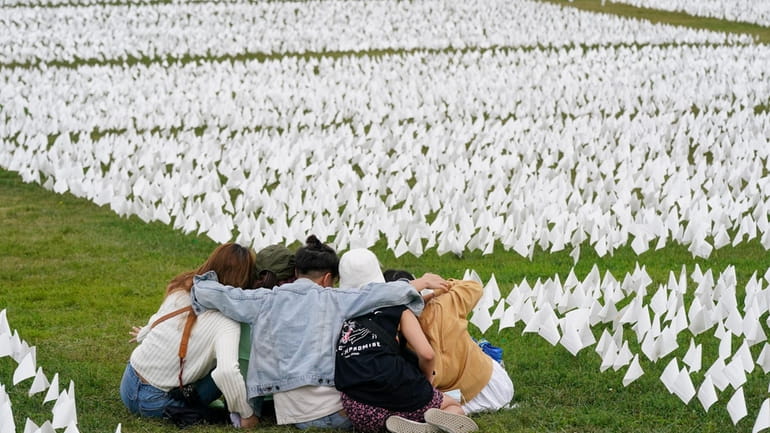Long Island braces for grim stat: 1 million in U.S. dead from COVID-19

Visitors to the National Mall in Washington at an art installation commemorating those who have died from COVID-19. Credit: AP/Patrick Semansky
Babylon resident Tracey Alvino still misses her father's voracious laughter — the type that would instantaneously light up a room, particularly during his larger-than-life family Christmas parties.
Daniel Alvino, 76, a Long Island Flag Football Hall of Fame referee and decorated Army veteran, died on April 14, 2020 of COVID-19 at a West Islip nursing and rehabilitation center where he had been recovering from neck surgery.
While the pain eases with the passage of time, on days such as Thursday, when the nation closed in on the bleak and once unthinkable milestone of 1 million COVID-19 deaths, it all comes rushing back.
"My dad was this loud, funny, gregarious, life-of-the-party man that just happened to be in a nursing home rehab at the wrong time," she said. " Heaven got a lot louder and unfortunately our lives got a lot more silent."
What to know
- COVID-19 has killed more than 996,000 people in the United States, according to the Centers for Disease Control and Prevention.
- More than 8,200 Long Islanders, including 4,397 in Suffolk and 3,851 in Nassau have died of the virus, according to the latest state data.
- New York, once the epicenter of the pandemic, now represents just over 7% of all COVID-19 deaths nationwide, with 71,103, according to state health department figures reported to the CDC.
COVID-19 has killed more than 996,000 people in the United States, according to the Centers for Disease Control and Prevention.
"We can't get numb or complacent by the numbers," said Dr. Steven Carsons, director of the Vaccine Center at NYU Langone Hospital-Long Island. "We can't just take it for granted that we are going to see hundreds or thousands of deaths … and just get used to it as the status quo. It certainly should not, in 2022, be the status quo."
Among those who have lost their lives to the disease are more than 8,200 Long Islanders, including 4,397 in Suffolk and 3,851 in Nassau, according to the latest state data.
New York, once the epicenter of the pandemic, now represents just over 7% of all COVID-19 deaths nationwide, with 71,103, according to state health department figures reported to the CDC. More than 86% of New Yorkers who have died from the virus were 60 or older. More than 55% were men, state data shows.
"These were mothers, fathers, children, siblings, friends and neighbors, and I don't want any more New Yorkers to go through the pain of losing a loved one to this awful virus," Gov. Kathy Hochul said Thursday as she, like President Joe Biden, marked the tragic milestone by directing flags to half-staff.
The official nationwide fatality figure is "an undercount unfortunately," said Dr. Aaron Glatt, chair of the department of medicine at Mount Sinai South Nassau hospital in Oceanside, as it fails to account for cases that went undiagnosed early in the pandemic and patients who died at home and were never tested for COVID-19.
While COVID-19 rates have spiked on Long Island, topping 10%, in part due to the contagiousness of the new omicron subvariant, fatality rates have remained low, averaging just a handful of deaths daily in Nassau and Suffolk.
Those numbers are a far cry from late April 2020 when, pre-vaccine, Long Island averaged nearly 160 deaths per day, according to state data. As recently as January, during the height of the initial omicron wave, the region had about 30 deaths per day on a seven-day average, the data shows.
With roughly three-quarters of all New Yorkers fully vaccinated — the rate in Nassau is higher at nearly 83% — fewer Long Islanders are getting severely ill, health officials said.
An unvaccinated adult is 68 times more likely to die of COVID-19 than someone fully vaccinated who received a booster shot, and 15 times more likely to die than a fully vaccinated person without a booster, according to CDC data.
Those who are still dying from COVID-19, Glatt said, are either unvaccinated or not boosted have serious comorbidities, or failed to seek treatment early on after getting sick.
Nearly 56% of eligible Long Islanders have gotten a booster. Glatt said despite the nation nearing 1 million dead, he sees glimmers of hope.
"We are seeing much better outcomes, even in people that previously would have died," Glatt said. "We are now able to prevent those deaths of people who are high-risk, older age, overweight or immunocompromised. … It's very optimistic-looking compared to where we were two years ago."
Nationwide, the United States is averaging 272 COVID-19 deaths per day, compared to nearly 3,400 in mid-January 2022, according to CDC data.
The improving trendlines, however, are small solace for Alvino, who serves as director of VoicesForSeniors, an advocacy group for the elderly in nursing homes.
Alvino said families who've lost loved ones to the virus often exist in a bubble, focused on their own grief and sadness.
"But then you realize, wow. A million people went through the same thing," she said. "A million grieving families. A million families that are feeling the way that I do that will never see their loved one again."
Clarification: The state numbers for Long Island death totals since the start of the pandemic are lower than the federal numbers, because they do not take into account deaths in certain settings.

